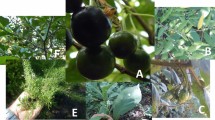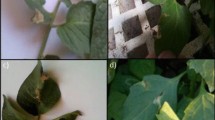Abstract
The tomato borer Tuta absoluta (Meyrick) (Lepidoptera: Gelechiidae) is an invasive pest that produces significant damage to tomato crops in the Mediterranean area. Although several species of predatory bugs are successfully being used for biological control of the pest, little is known about the parasitoids that are able to exploit T. absoluta as a host. With the aim of better understanding parasitoid species richness of T. absoluta along the Mediterranean Spanish Coast, we conducted an extensive survey to determine distribution, host plants and habitats where parasitoids are present. Our results indicated that egg parasitoids are naturally scarce but that the species richness of larval/pupal parasitoids is high and includes 20 different species. Seven of these had not been previously reported as T. absoluta parasitoids. The most frequent parasitoid species recovered were Necremnus sp. nr. artynes (Walker), Stenomesius cf. japonicus (Ashmead) and Neochrysocharis formosa (Westwood) (Hymenoptera: Eulophidae).

Similar content being viewed by others
References
Al-Jboory IJ, Katbeh-Bader A, Shakir A (2012) First observation and identification of some natural enemies collected from heavily infested tomato by Tuta absoluta (Meyrick) (Lepidoptera: Gelechiidae) in Jordan. Middle-East J Sci Res 11(4):435–438
Alomar O, Gabarra R, González O, Arnó J (2006) Selection of insectary plants for ecological infrastructures in Mediterranean vegetable crops. IOBC/WPRS Bull 20:5–8
Arnó J, Gabarra R (2011) Side effects of selected insecticides on the Tuta absoluta (Lepidoptera: Gelechiidae) predators Macrolophus pygmaeus and Nesidiocoris tenuis (Hemiptera: Miridae). J Pest Sci 84:513–520
Arnó J, Sorribas R, Prat M, Matas M, Pozo C, Rodríguez D, Garreta A, Gomez A, Gabarra R (2009) Tuta absoluta, a new pest in IPM tomatoes in the northeast of Spain. IOBC/WPRS Bull 49:203–208
Arnó J, Gabarra R, Liu TX, Simmons AM, Gerling D (2010a) Natural enemies of Bemisia tabaci: Predators and parasitoids. In: Stansly PA, Naranjo SE (eds) Bemisia: bionomics and management of a global pest. Springer, Dordrecht, The Netherlands, pp 385–421
Arnó J, Castañé C, Riudavets J, Gabarra R (2010b) Risk of damage to tomato crops by the generalist zoophytophagous predator Nesidiocoris tenuis (Reuter) (Heteroptera: Miridae). Bull Entomol Res 100:105–115
Arnó J, Gabarra R, Alomar O (2012) Hymenoptera abundance on candidate plants for conservation biological control. IOBC/WPRS Bull 75:13–16
Bernardo U, Monti MM, Nappo AG, Gebiola M, Russo A, Pedata PA, Viggiani G (2008) Species status of two populations of Pnigalio soemius (Hymenoptera: Eulophidae) reared from two different hosts: an integrative approach. Bio Control 46:293–303
Boualem M, Allaoui H, Hamadi R, Medjahed M (2012) Biologie et complexe des ennemis naturels de Tuta absoluta à Mostaganem (Algérie). EPPO Bull 42:268–274
Burgio G, Lanzoni A, Navone P, van Achterberg K, Masetti A (2007) Parasitic Hymenoptera fauna on Agromyzidae (Diptera) colonizing weeds in ecological compensation areas in northern Italian agroecosystems. J Econ Entomol 100:298–306
Cabello T, Gallego JR, Fernández FJ, Gámez M, Vila E, Del Pino M, Hernández-Suárez E (2012) Biological control strategies for the South American tomato moth (Lepidoptera: Gelechiidae) in greenhouse tomatoes. J Econ Entomol 105:2085–2096
Calvo FJ, Lorente MJ, Stansly PA, Belda JE (2012) Preplant release of Nesidiocoris tenuis and supplementary tactics for control of Tuta absoluta and Bemisa tabaci in greenhouse tomato. Entomol Exp Appl 143:111–119
Calvo FJ, Soriano JD, Bolckmans K, Belda JE (2013) Host instar suitability and life-history parameters under different temperature regimes of Necremnus artynes on Tuta absoluta. Biocontrol Sci Techn 23:803–815
Castañé C, Arnó J, Gabarra R, Alomar O (2011) Plant damage to vegetable crops by zoophytophagous mirid predators. Biol Cont 59:22–29
Chailleux A, Desneux N, Seguret J, Do Thi Khanh H, Maignet P, Tabone E (2012) Assessing european egg parasitoids as a mean of controlling the invasive south American tomato pinworm Tuta absoluta. PLoS One 7(10):e48068
Chailleux A, Bearez P, Pizzol J, Amiens-Desneux E, Ramirez-Romero R, Desneux N (2013) Potential for combined use of parasitoids and generalist predators for biological control of the key invasive tomato pest Tuta absoluta. J Pest Sci 86:533–541
Cornell HV, Hawkins BA (1993) Accumulation of native parasitoid species on introduced herbivores: a comparison of “hosts-as-natives” and “hosts-as-invaders”. Am Nat 141:847–865
DeBach P, Rosen D (1991) Biological control by natural enemies, 2nd edn. Cambridge University Press, Cambridge, UK
Desneux N, Wajnberg E, Wyckhuys K, Burgio G, Arpaia S, Narváez-Vasquez C, González-Cabrera J, Catalán-Ruescas D, Tabone E, Frandon J, Pizzol J, Poncet C, Cabello T, Urbaneja A (2010) Biological invasion of European tomato crops by Tuta absoluta: Ecology, geographic expansion and prospects for biological control. J Pest Science 83:197–215
Desneux N, Luna MG, Guillemaud T, Urbaneja A (2011) The invasive South American tomato pinworm, Tuta absoluta, continues to spread in Afro-Eurasia and beyond: the new threat to tomato world production. J Pest Sci 84:403–408
Doğanlar M, Yiğit A (2011) Parasitoids complex of the Tomato Leaf Miner, Tuta absoluta (Meyrick 1917), (Lepidoptera: Gelechiidae) in Hatay. Turkey. KSU J Nat Sci 14(4):28–37
Ehler LE (1998) Invasion biology and biological control. Bio Control 13:127–133
Ferracini C, Ingegno BL, Navone P, Ferrari E, Mosti M, Tavella L, Alma A (2012) Adaptation of indigenous larval parasitoids to Tuta absoluta (Lepidoptera: Gelechiidae) in Italy. J Econ Entomol 105:1311–1319
Gabarra R, Besri M (1999) Implementation of IPM: case studies tomatoes. In: Albajes R, Gullino ML, van Lenteren JC, Elad Y (eds) Integrated pest and disease management in greenhouse crops. Kluwer Academic Publishers, Dordrecht, The Netherlands, pp 420–434
Gebiola M, Bernardo U, Burks RA (2010) A reevaluation of the generic limits of Pnigalio Schrank (Hymenoptera: Eulophidae) based on molecular and morphological evidence. Zootaxa 2484:35–44
Gerling D, Alomar O, Arnó J (2001) Biological control of Bemisia tabaci using predators and parasitoids. Crop Prot 20:779–799
González-Cabrera J, Mollá O, Montón H, Urbaneja A (2011) Efficacy of Bacillus thuringiensis (Berliner) for controlling the tomato borer, Tuta absoluta (Meyrick) (Lepidoptera: Gelechiidae). BioControl 56:71–80
Guedes RNC, Picanço MC (2012) The tomato borer Tuta absoluta in South America: pest status, management and insecticide resistance. EPPO Bull 42:211–216
Lara L, Aguilar R, Salvador E, Téllez MM (2010) Estudios de control biológico de la polilla del tomate Tuta absoluta Meyrick (Lepidoptera; Gelichiidae) en cultivos hortícolas de invernadero del Sureste Español. Phytoma-España 221:39–42
Loni A, Rossi E, van Achterberg K (2011) First report of Agathis fuscipennis in Europe as parasitoid of the tomato leafminer Tuta absoluta. Bull Insectol 64:115–117
Luna MG, Wada VI, La Salle J, Sánchez NE (2011) Neochrysocharis formosa (Westwood) (Hymenoptera: Eulophidae), a newly recorded parasitoid of the Tomato Moth, Tuta absoluta (Meyrick) (Lepidoptera: Gelechiidae), in Argentina. Neotrop Entomol 40:412–414
Luna MG, Sánchez NE, Pereyra PC, Nieves E, Savino V, Luft E, Virla E, Speranza S (2012) Biological control of Tuta absoluta in Argentina and Italy: evaluation of indigenous insects as natural enemies. EPPO Bull 42:260–267
Massa B, Rizzo MC, Caleca V (2001) Natural alternative hosts of Eulophidae (Hymenoptera: Chalcidoidea) parasitoids of the citrus leafminer Phyllocnistis citrella Stainton (Lepidoptera: Gracillariidae) in the Mediterranean basin. J Hymenopt Res 10:91–100
Mollá O, González-Cabrera J, Urbaneja A (2011) The combined use of Bacillus thuringiensis and Nesidiocoris tenuis against the tomato borer Tuta absoluta. BioControl 56:883–891
Nicoli G (1997) Biological control of exotic pests in Italy: recent experiences and perspectives. EPPO Bull 27:69–75
Polaszek A, Rugman-Jones PF, Stouthamer R, Hernández-Suárez E, Cabello T, del Pino-Pérez M (2012) Molecular and morphological diagnoses of five species of Trichogramma: biological control agents of Chrysodeixis chalcites (Lepidoptera: Noctuidae) and Tuta absoluta (Lepidoptera: Gelechiidae) in the Canary Islands. BioControl 57:21–35
R Development Core Team (2008) R: a language and environment for statistical computing. R Foundation for Statistical Computing, Vienna, http://www.r-project.org. (accessed 20 July 2013)
Schmidt MH, Thies C, Tscharntke T (2004) The landscape context of arthropod biological control. In: Gurr GM, Wratten SD, Altieri MA (eds) Ecological engineering for pest management: advances in habitat manipulation for arthropods. CSIRO, Melbourne, Australia, pp 55–64
Stansly PA, Sánchez PA, Rodríguez JM, Cañizares F, Nieto A, López-Leyva MJ, Fajardo M, Suárez V, Urbaneja A (2004) Prospects for biological control of Bemisia tabaci (Homoptera, Aleyrodidae) in greenhouse tomatoes of southern Spain. Crop Prot 23:701–712
Sumer F, Tuncbilek AS, Oztemiz S, Pintureau B, Rugman-Jones P, Stouthamer R (2009) A molecular key to the common species of Trichogramma of the Mediterranean region. BioControl 54:617–624
Urbaneja A, Llacer E, Tomas O, Garrido A, Jacas JA (2000) Indigenous natural enemies associated with Phyllocnistis citrella (Lepidoptera: Gracillariidae) in eastern Spain. BioControl 18:199–207
Urbaneja A, Vercher R, Navarro V, García Marí F, Porcuna JL (2007) La polilla del tomate, Tuta absoluta. Phytoma España 194:16–23
Urbaneja A, Montón H, Mollá O (2009) Suitability of the tomato borer Tuta absoluta as prey for Macrolophus pygmaeus and Nesidiocoris tenuis. J Appl Entomol 133:292–296
Urbaneja A, González-Cabrera J, Arnó J, Gabarra R (2012) Prospects for the biological control of Tuta absoluta in tomatoes of the Mediterranean basin. Pest Manag Sci 68:1215–1222
Zappalà L, Bernardo U, Biondi A, Cocco A, Deliperi S, Delrio G, Giorgini M, Pedata P, Rapisarda C, Tropea Garzia G, Siscaro G (2012) Recruitment of native parasitoids by the exotic pest Tuta absoluta in Southern Italy. Bull Insectol 65:51–61
Zucchi RA, Querino RB, Monteiro RC (2010) Diversity and hosts of Trichogramma in the New World, with emphasis in South America. In: Consôli FL, Parra JRP, Zucchi RA (eds) Egg parasitoids in agroecosystems with emphasis on Trichogramma. Springer, Dordrecht, The Netherlands, pp 219–236
Acknowledgments
The authors wish to thank Marco Gebiola and Umberto Bernardo (Institute for Plant Protection, Napoli, Italy), Richard Askew (United Kingdom), Cornelius van Achterberg (National Museum of Natural History, Leiden, Netherlands) and Mark Shaw (National Museums of Scotland, United Kingdom) for the revision of some species of Eulophidae, Braconidae and Microgastrinae respectively; also Jesus Selfa (Universidad de Valencia, Spain) and Santiago Bordera (Universidad de Alicante, Spain) for the verification of Ichneumonidae parasitoids. We are also grateful to Ramon Berruezo and Clara Balaguer for their technical assistance, to TRAGSA (Spain) for providing T. absoluta-infested samples from the Comunitat Valenciana and to Agnès Ardanuy for assistance with statistical analysis. Authors thank two anonymous reviewers for helpful comments on an earlier version of the manuscript. This work has been funded by the Instituto Nacional de Investigación y Tecnología Agraria (INIACC09-048), the Ministerio de Economía y Competitividad (AGL 2010-18811), the Conselleria d’Agricultura, Pesca i Alimentació de la Generalitat Valenciana, the Conselleria d’Agricultura, Ramaderia, Pesca, Alimentació i Medi Natural de la Generalitat de Catalunya and the Consejería de Agricultura y Pesca de la Junta de Andalucía (IFAPA - IDF-09-06 Feder).
Author information
Authors and Affiliations
Corresponding author
Additional information
Handling Editor: Stefano Colazza.
Rights and permissions
About this article
Cite this article
Gabarra, R., Arnó, J., Lara, L. et al. Native parasitoids associated with Tuta absoluta in the tomato production areas of the Spanish Mediterranean Coast. BioControl 59, 45–54 (2014). https://doi.org/10.1007/s10526-013-9545-8
Received:
Accepted:
Published:
Issue Date:
DOI: https://doi.org/10.1007/s10526-013-9545-8




